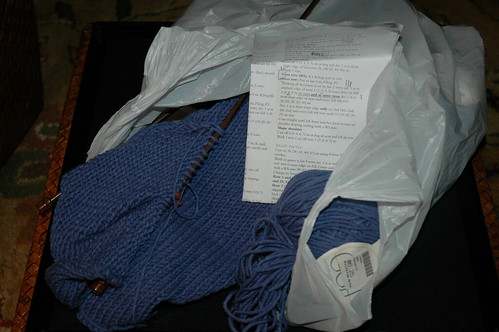In the center of my living room, in front of my spot on the sofa is an unassuming ottoman with a Peruvian saddle blanket thrown over it with artistic carelessness. The saddle blanket is alpaca, warm browns with several wee strips of cholo pink running down its length. It has been with my family since my birth in Miraflores, Peru, it is an old piece, and quite subdued by Peruvian standards, but I love it. To the untrained eye this little tableaux is not the focal point of the living room, just a place where one might rest a foot, a book, or a nice glass of Cabernet (or as pictured below, freshly brewed Cafe Americaine).

But the trained eye will notice that the saddle blanket conceals a form that might well be hollow, a container if you will. Upon removal of the blanket you will notice that the top of the ottoman is a lid. When you open the lid you will find a squirming multitude of bags, yarn, needles, books and the other detritus of a knitter.

Lets examine this find layer by layer shall we?

On the top we find a ball of rich blue alpaca attached to a three and half inch knit on #8 circulars. It appears that the #8s have been gently gnawed by a large omnivore of some sort of another. On this same layer we find a ball of chartreuse wool (Cascade 220 we assume, but since the labels have long been lost we may have to send a sample off to the LYS to have it verified). We also find a tattered notebook of graph paper, the first page of which is covered in some sort of code or hieroglyphs. Two threads of the above-mentioned yarns are taped to this page, so we can safely assume that this layer should be grouped together.

Our next layer is a self-contained unit; a Walgreen's bag. It appears to be 6-8 skeins of GGH Samoa in a pretty twilight blue, a finished back, and a partially finished left front on a pair of dark wood #8s. There is a crumpled paper, stuffed in this bag revealing a Rowan pattern for a light summer bolero called Iris. These items appear to have been shoved in this bag in haste or disgust. We realize that it is unscientific to make assumptions of this sort, but we notice that the needles have punctured the bag, and the balls of yarn appear to have been knit and frogged several times. Is this a project that caused the knitter undue distress?

Our next layer reveals another self-contained unit. A bag or basket knit in the very same colors as the yarns revealed in the first layer. This bag contained three balls of smoky, pale blue alpaca, a completed back (?) of a short sweater, a pair of Crystal Palace #10.5 circulars, a wound ball of smoke grey silk (possibly Lorna’s Lace, again we will have to wait for the lab results for positive identification). An Altoids tin filled with tapestry needles, pins, and short loops of yarn. Finally a tape measure that depicts a dog and its bone. This bag does not appear to relate to any specific project, so we can only assume that the knitter had something in mind for these beautiful fibers.

Our next layer reveals a ball of orange yarn and a ball of grass green yarn. These do not appear to have any relation to the above layers. Again they may or may not be Cascade 220. Under these possibly "ceremonial" balls of yarn we find a compartmentalized plastic box filled with beads. This might be viewed as an incongruous item to be found in a knitting dig, however upon inspection of some of the printed material we have noted that beads are used in some of the knitted items. It does not look as though there are enough beads of any one type to complete any of the projects outlined in the printed material, so it maybe that the knitter was begining to apprentice in this technique.
Finally we turn our attention to the vertical layers (not pictured, but you can see them in the edges of some of the above photo documentation), comprised of primarily printed materials and tools. In this layer we find titles such as Loop-d-Loop, sevearl Rowan Magazines, and Knitting on the Edge. There is also a stack of index cards held together with a binder ring; some of the index cards are covered in a similar code to the graph paper pad, some of them are blank. There is a small jar wedged in the corner that holds a variety of knitting needles, safety pins, and a pair of pink handled children’s craft scissors, which are terribly dull.
It is clear that this site was abandoned in haste. All of the items appear to have been in use at the time that the site was abandoned except the ball orange yarn and the ball of grass green yarn, although it is possible that they had some ritual significance. We will submit a full report when we have had time to review this dig further.

2 comments:
Has x-ray crystallography, carbon-14 dating or other advanced technologies solved any of the additional mysteries of the knitting basket?
The fibers are still at the lab...
and this knitter has had too, too much on her plate this past week to even pick up her sticks! Terrible isn't it, how summer gets in the way!
Post a Comment